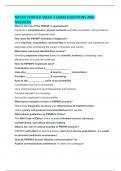1
The Effect of the Mass of the Pendulum Bob on Damping
Introduction
In school, we were learning about the simple harmonic motion of pendulums one day and we were
given a demonstration where the teacher set up a heavy pendulum hanging from the ceiling and
lined it up with his face and let go, we were all amazed at how it didn't hit him when it swung back. I
tried doing it and was intrigued as to why the pendulum just reached its amplitude before my face.
This was the first time I came across damping, and I found it interesting. I was then disappointed to
find out that the physics behind damping was not in our course which led me to my research
question below.
Research Question: How Does the Mass of The Pendulum Bob Affect the
Damping in a Simple Pendulum?
Background Information
A simple pendulum consists of a weighted bob attached to a fulcrum through a
string and when displaced, it oscillates. They have many real-world applications
such as grandfather clocks and metronomes. The simple pendulum Is a textbook
example of simple harmonic motion, which is when the acceleration is
proportional to negative displacement and the restoring force is directed Figure 1 (brainkart, 2018)
towards the equilibrium position. This position is where the bob is directly below showing an example of a
the pivot point, displacement is 0. pendulum being used in a
grandfather clock.
Theoretically, pendulums should oscillate in simple harmonic motion forever due
to the law of conservation of energy which states that energy can neither be created nor destroyed -
only converted from one form of energy to another. This means that a system always has the same
amount of energy (Ethan Boechler et al, 2021). In a pendulum, the potential energy converts into
kinetic energy as it swings (Brittanica, 2022). In the real world, energy is lost because of resistive
forces which reduce the amplitude of each oscillation. This phenomenon is known as damping. The
pendulum system loses more and more energy until it eventually stops moving.
For a system that has a small amount of damping, the period and frequency are nearly the same as
for simple harmonic motion, but the amplitude gradually decreases as shown in Figure 1.1. The main
reason for damping is friction, in the form of aerodynamic drag or friction in the fulcrum. (The
University of Iowa, n.d.).
Figure 1.1 shows us that the
rate of damping is not linear, it
decreases over time.
Figure 1.1 (The University of Iowa, n.d.)This graph shows the
effects of damping where:X is amplitudeT is time period
, 2
Inertia is known as an objects tendency to resist change in motion, it comes from newtons first law
which is "An object at rest stays at rest and an object in motion stays in motion with the same speed
and in the same direction unless acted upon by an unbalanced force." (The Physics Classroom, n.d.).
This relates to my experiment in the way that an increase in inertia will make the pendulum bob
resist damping forces more, reducing the damping. The moment of inertia in a simple pendulum is
given by (libretexts, 2022):
I =mL ²
Where I is inertia, m is the mass and L is the length of the string.
The inertia in my investigation will increase because as the mass of the pendulum bob increases, so
does the momentum carried by the pendulum bob which means a larger damping force is required
to counteract the energy carried by the pendulum.
the dimensions of the string and the shape of the pendulum bob affects the air resistance, affecting
damping, however if the mass of the bob is increased with a constant shape and volume then
theoretically damping will decrease because of the increase in momentum carried by the pendulum
and hence the increased inertia since more force is needed to counteract the momentum carried by
the bob to damp it. If the mass is increased and the volume is also increased, there may be a volume
with so much air resistance that it counteracts the increase in inertia and the pendulum oscillations
get damped more.
Hypothesis
I hypothesise that the Mass of the Bob is inversely exponential to the rate of damping. I think this is
because as the mass of the bob increases, the bob will have more momentum, hence more inertia so
it will have a greater opposition to damping forces such as air resistance. I think damping and mass
will be specifically inversely exponentially because damping can never reach 0 or go below it, energy
will always be lost, no matter how much inertia the bob carries, otherwise it would be perpetual.
Variables
The dependant variable is the displacement from the equilibrium position. The independent variable
is the mass of the bob.
Control Variables:
- The dimensions of the string - the length would affect the results since it's used to calculate
the amplitude (page 5). The width and length would affect the drag acting on the pendulum
which is a resistive force that plays a part in damping. I will use the same string throughout
the experiment (0.0008m diameter)
- The initial angular amplitude the pendulum is released from – this could affect the results
since every mass must be released from the same angle for the damping to be comparable,
because the damping is the original amplitude minus the damped amplitude. I will release it
from 1 radian.
The Effect of the Mass of the Pendulum Bob on Damping
Introduction
In school, we were learning about the simple harmonic motion of pendulums one day and we were
given a demonstration where the teacher set up a heavy pendulum hanging from the ceiling and
lined it up with his face and let go, we were all amazed at how it didn't hit him when it swung back. I
tried doing it and was intrigued as to why the pendulum just reached its amplitude before my face.
This was the first time I came across damping, and I found it interesting. I was then disappointed to
find out that the physics behind damping was not in our course which led me to my research
question below.
Research Question: How Does the Mass of The Pendulum Bob Affect the
Damping in a Simple Pendulum?
Background Information
A simple pendulum consists of a weighted bob attached to a fulcrum through a
string and when displaced, it oscillates. They have many real-world applications
such as grandfather clocks and metronomes. The simple pendulum Is a textbook
example of simple harmonic motion, which is when the acceleration is
proportional to negative displacement and the restoring force is directed Figure 1 (brainkart, 2018)
towards the equilibrium position. This position is where the bob is directly below showing an example of a
the pivot point, displacement is 0. pendulum being used in a
grandfather clock.
Theoretically, pendulums should oscillate in simple harmonic motion forever due
to the law of conservation of energy which states that energy can neither be created nor destroyed -
only converted from one form of energy to another. This means that a system always has the same
amount of energy (Ethan Boechler et al, 2021). In a pendulum, the potential energy converts into
kinetic energy as it swings (Brittanica, 2022). In the real world, energy is lost because of resistive
forces which reduce the amplitude of each oscillation. This phenomenon is known as damping. The
pendulum system loses more and more energy until it eventually stops moving.
For a system that has a small amount of damping, the period and frequency are nearly the same as
for simple harmonic motion, but the amplitude gradually decreases as shown in Figure 1.1. The main
reason for damping is friction, in the form of aerodynamic drag or friction in the fulcrum. (The
University of Iowa, n.d.).
Figure 1.1 shows us that the
rate of damping is not linear, it
decreases over time.
Figure 1.1 (The University of Iowa, n.d.)This graph shows the
effects of damping where:X is amplitudeT is time period
, 2
Inertia is known as an objects tendency to resist change in motion, it comes from newtons first law
which is "An object at rest stays at rest and an object in motion stays in motion with the same speed
and in the same direction unless acted upon by an unbalanced force." (The Physics Classroom, n.d.).
This relates to my experiment in the way that an increase in inertia will make the pendulum bob
resist damping forces more, reducing the damping. The moment of inertia in a simple pendulum is
given by (libretexts, 2022):
I =mL ²
Where I is inertia, m is the mass and L is the length of the string.
The inertia in my investigation will increase because as the mass of the pendulum bob increases, so
does the momentum carried by the pendulum bob which means a larger damping force is required
to counteract the energy carried by the pendulum.
the dimensions of the string and the shape of the pendulum bob affects the air resistance, affecting
damping, however if the mass of the bob is increased with a constant shape and volume then
theoretically damping will decrease because of the increase in momentum carried by the pendulum
and hence the increased inertia since more force is needed to counteract the momentum carried by
the bob to damp it. If the mass is increased and the volume is also increased, there may be a volume
with so much air resistance that it counteracts the increase in inertia and the pendulum oscillations
get damped more.
Hypothesis
I hypothesise that the Mass of the Bob is inversely exponential to the rate of damping. I think this is
because as the mass of the bob increases, the bob will have more momentum, hence more inertia so
it will have a greater opposition to damping forces such as air resistance. I think damping and mass
will be specifically inversely exponentially because damping can never reach 0 or go below it, energy
will always be lost, no matter how much inertia the bob carries, otherwise it would be perpetual.
Variables
The dependant variable is the displacement from the equilibrium position. The independent variable
is the mass of the bob.
Control Variables:
- The dimensions of the string - the length would affect the results since it's used to calculate
the amplitude (page 5). The width and length would affect the drag acting on the pendulum
which is a resistive force that plays a part in damping. I will use the same string throughout
the experiment (0.0008m diameter)
- The initial angular amplitude the pendulum is released from – this could affect the results
since every mass must be released from the same angle for the damping to be comparable,
because the damping is the original amplitude minus the damped amplitude. I will release it
from 1 radian.










